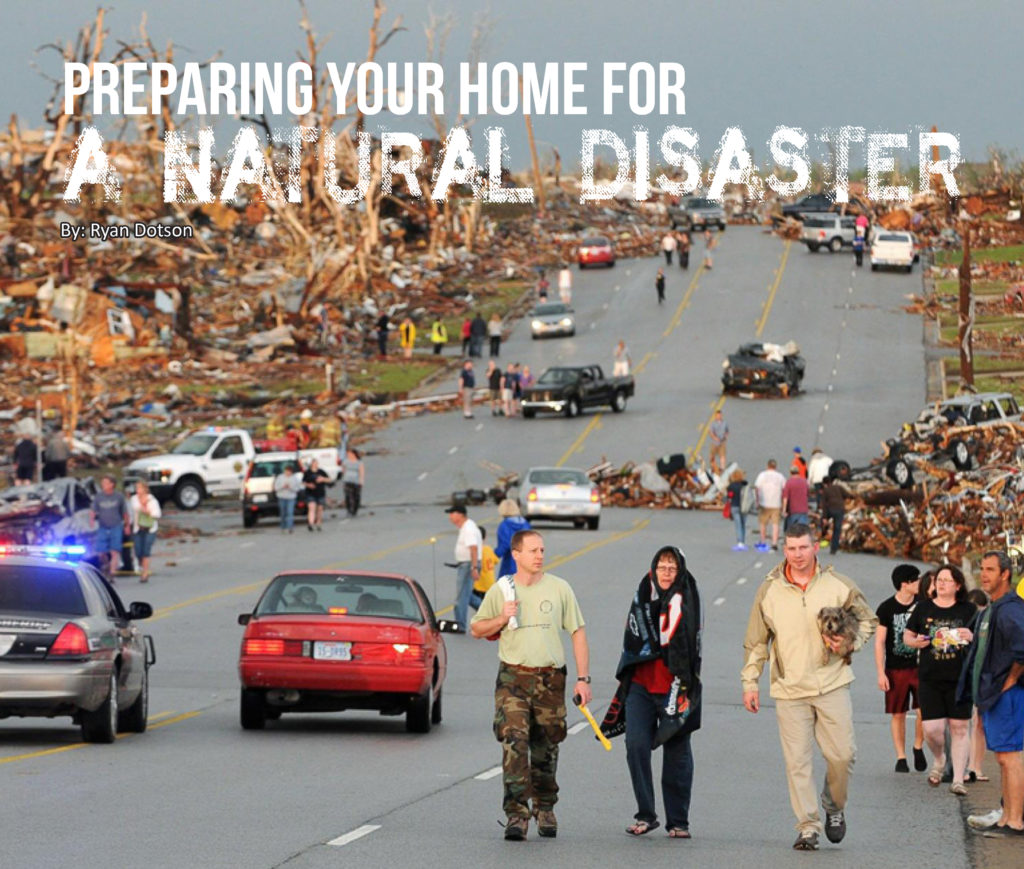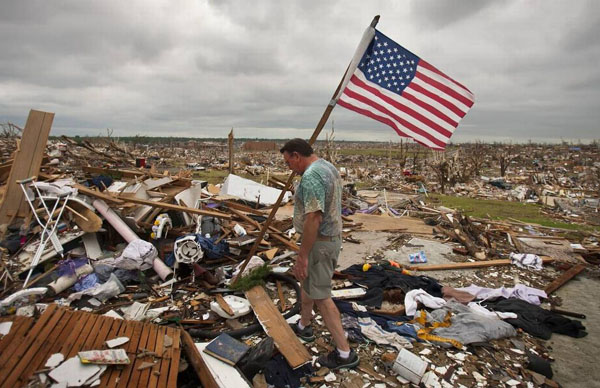
We’re once again approaching what most consider to be natural disaster season. This past year was one of the worst hurricane seasons on record, and they were almost all between June and November. Plus, it seems like these hurricanes are more powerful than ever. These storms rip apart homes with high winds and drive families onto their roofs with flooding.
Seismic activity seems to gradually be increasing. This makes earthquakes and tsunamis more common and more powerful than ever. These forces have leveled entire countries over the past few years and caused thousands of deaths.
While it may seem strange, both droughts and flooding have increased simultaneously. The lack of rain we’ve seen in the West and Southwest have dried up crops and turned the area into a dustbowl. Dried out forests have become tinder for wildfires. On the other hand, heavy rains in other parts of the country have swallowed up entire towns. In addition, sudden rains in California have caused mudslides that have swallowed homes and caused entire streets to drop into the ocean.

Since I live in tornado alley, hearing the sirens sound has been a regular part of life. However, the number and strength of tornadoes has increased over the last few years as well. Now we’re seeing these storms in places they’ve never been seen. They seem to pop up like popcorn across the weather map of the country.
An example of the severity of tornadoes can be seen in Joplin, MO. This 2011 storm came in with 200 mph winds leveling both the school and hospital. On that day, 161 people were killed and 1,150 people were injured.
I’m sure everybody has stories like these of how natural disasters have affected their loved ones. The point is that we need to learn from these sad stories. In most cases, people weren’t fully prepared for these events.
With some simple but rigorous preparations of your home and family, you can be sure that these natural disasters cause as little damage as possible. In this article, I will break down the suggested plan of action for the worst of these disasters.
Hurricanes/Flooding
Believe it or not, hurricanes and flooding are disasters for which one truly can prepare. People in hurricane and flood zones know that they live in areas that are at risk. In addition, these storms take days to develop. You can see them coming from hundreds of miles away. However, thousands of people are caught unprepared every time one of these events takes place. After every flood, you see people throwing out ruined furniture. Every time there is a hurricane, you see people stuck on their roofs begging to be rescued. Here are the steps you can take to prepare your household for hurricanes and flooding:
- Know Your Utilities – One of the biggest issues with any type of flooding is the damage to utility lines. If you know flooding is going to be an issue, shut down your power and gas. You need to know where these cutoffs are located in order to do this. Furthermore, you should have a family meeting to be sure everybody knows how to shut down your utilities.
- Have A Way Out – I recently read a story of an elderly couple that stayed in their home during Katrina. They ended up forced into the attic because of high waters below. They had no way out of their home as the waters continued to rise. Thankfully they were able to break open a vent and escape, but this scenario should never happen. You should always have a rescue axe or some other tool to bust out of your home.
- Prepare Lower Levels – Basements and ground level floors are the first to be swallowed up by flooding. Be prepared to move furniture or any valuables off of these floors if at all possible.
- Protect Windows and Doors – For hurricanes you should always have plywood or particle board on hand to board up all of the windows and most of the doors. Of course, always leave yourself a way out of the house, preferably on high ground.
- Consider The Yard – Many people have furniture, grills, and toys that are left on patios and in the yard. Try to limit the value of these items, and immediately move them inside when a storm is coming.
- Have A Plan To GET OUT – I cannot emphasize this enough. If a hurricane or flooding is headed your way, you should have several days to prepare. Most people will wait for an evacuation order before leaving their home. Don’t make this mistake. By this time, highways are jammed up and gas stations are dry. Have a backup location outside of the flood zone and get there before everybody else starts to panic.
Tornados
Unfortunately, tornados are not quite as cut and dry. Normally you only have a few minutes of notice. However, there are preparations that can be made for this scenario. Here are the preparations you can make for tornados:
- Identify A Safe Zone – In this case, “safe” is a relative word. However, in any home there are rooms that are safer than others. A basement or root cellar is always going to be the best location. Moving underground has saved many people’s lives. If this isn’t an option, get to an interior bathroom. The piping in the walls and lack of windows make it your second best option.
- If You Live In A Trailer, Have A Plan – Trailers are death traps in tornados. If you live in a trailer, plan to have a solid structure close to your home in the event of a tornado.
- Watch The Windows – In most cases, you’ll not have enough time to board up windows. That being said, you do need to be aware of the glass. Stay far away from windows and cover them from the inside if possible.
- Discuss A Plan With Your Family – The most important thing with tornados is knowing what action to take. Be sure your family knows to listen for tornado sirens, listen to weather radios, and watch the weather on TV. Ensure everybody in the family knows what room to go in. Discuss duck and cover using items like cushions and mattresses to protect from debris.
- Know Your Utilities – As with flooding, damaged gas and electric lines can be a huge issue after a tornado. If the home is damaged and everybody is unharmed, your next job should be to shut down the utilities.
Earthquakes
Seismic activity can’t be predicted like weather. Therefore, you have zero warning during an earthquake. All of the work must be done in advance.
- Secure Your Furniture – One of the most important preparations you can make for earthquakes is to prevent falling furniture. All tall items such as bookshelves and wardrobes should be anchored to the wall. You may also want to secure glass covered pictures on the wall and avoid having too many items on high shelves. Falling debris is one of the biggest risks of an earthquake.
- Have A Plan – In the case of an earthquake, your plan of action is more important than most other scenarios. Discuss with your family how to drop, secure, and cover. Have them avoid windows, hold onto something solid, and get on the ground without trying to walk anywhere.
- Have Supplies – There is a good chance that you could be trapped in your home after an earthquake. You’ll need plenty of water, food, blankets, and flashlights along with a first aid kit.
- Method Of Communication – There has to be a way to reach emergency services or family in the event that you’re trapped. This could just be cell phones but having a backup such as a radio is a good idea.
- Utilities – Again, know how to shut off the electricity and gas.
Landslides
These nasty events can be caused by a variety of different catalysts, but they all are related to ground structure. The best thing to do to avoid a landslide is do your research before you buy or rent a home. You can then avoid the issue altogether. If you’re already living in a landslide zone, here are a few preparations you can make:
- Consider Your Land – To help prevent landslides, you can make modifications to your yard. Be sure to have some sort of ground cover planted on any slopes. Having trees and a thick lawn can help as well. You may also want to use retaining or diversion walls to protect your home and keep the earth in place.
- Modify The Home – There are modifications that can be made to your home to make it more resistant to landslides. Flexible fittings for utilities is just one example. See a contractor for more options.
- Have A Plan – You’ll need to treat a mudslide like an earthquake. When you feel the ground rumbling, get down, secure, and take cover. Stay away from glass and possible falling debris. Shut off utilities, and have a way to call for help.
Digging Deeper
The type of preparation you need to make for tornados is vastly different than what you need to do to get ready for potential flooding. The information provided above will give you some quick suggestions for basic survival, but it us by no means conclusive.
In the next few sections, we will dig deeper, taking a closer look at lifesaving tips for each natural disaster. In addition, we will cover common myths and misunderstandings that can cause more harm than good.
